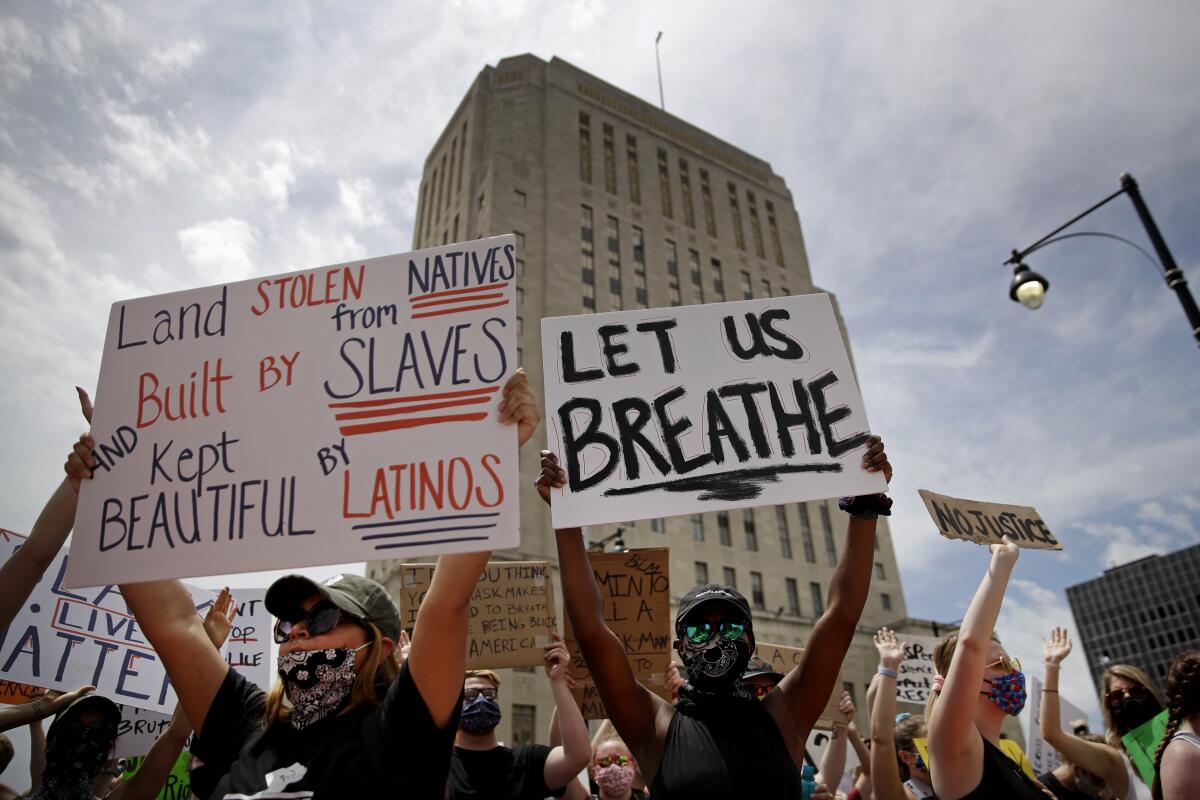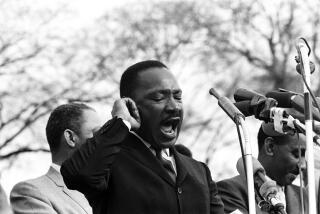I just drove from Missouri to California. What I learned from protests across America

- Share via
“Don’t forget your mask.”
“We should have brought our signs.”
My two eldest children and I recently took a road trip from the middle of Missouri to the Los Angeles foothills and these words (along with “wait, what are you eating?”) formed the leitmotif of our travels. Masks and signs. Pandemic and protest. Across almost 2,000 miles and some of the most gorgeous landscape this country has on offer, we traveled a country demanding protection and change.
Protection from a virus that has claimed more than 100,000 lives in the U.S. and a system of racism that has claimed millions more. Change that will mean we each take responsibility for how our actions, large and small, can harm or help others.
Needless to say, not everyone agrees about any of this. Across six states, we saw many posted reminders that face coverings are recommended or required, and many people ignoring them. Across six states, most of them historically red, we saw thousands of people gathering to protest inarguable instances of police brutality and racist policy, and many people ignoring those too.
Following protests across the country was not the point of this journey; we were just trying to get home as quickly as possible. But the protests were ubiquitous. Hence my children’s decision that they should start carrying signs everywhere just as they have begun carrying face masks and hand sanitizer.
Or at least get some masks with protest slogans on them.
It was no surprise that Black people, Latinos and other communities of color were being disproportionately affected by COVID-19 even before data made it crystal clear.
The trip itself rose from the COVID-19 crisis. Like thousands of colleges, the University of Missouri closed in mid-March; my son had stayed in Columbia to finish his capstone project while we canceled our plans to see him graduate. (The school’s documentary journalism program did hold a small, ad-hoc and socially distant ceremony in, fittingly enough, a movie theater parking lot.)
With so many states under stay-at-home orders, and California having a much higher infection rate than Missouri, Danny decided to stay on past graduation; his original plan of making his way home on a meandering road trip with friends (before, not that I’m going to mention this immediately, finding a job) no longer made sense.
But heading into June, his lease was almost up, and with states beginning to open, we decided that my daughter Fiona and I would fly to Columbia and drive home with him to minimize the number of stops he would have to make along the way.
Then the protests began. My children joined them (Danny in Columbia, the girls in L.A.), signed petitions and donated to bail funds, called on their schools to disassociate from local police and change racist policies.
But still we needed to get Danny home.
Traveling during a pandemic reveals, if nothing else, the overcrowding and occasional ridiculousness of traveling before a pandemic. LAX was quiet but not empty, even at 5:30 a.m. Many of its stores and restaurants were closed, which was less of an inconvenience than a reckoning. Do we really need to have a Spanx store and three smoothie stands in an airport?
At first, there were no flight health protocols amid the coronavirus outbreak. Now there are. I feel more confident. I hope passengers do too.
On the plane, breakfast consisted of a paper bag containing a bottle of water, a sack of pretzels and a packet of cookies but then again, I don’t think anyone actually looks forward to airline food. Fiona has been a wiper-down of seats since she was young, and as it turns out wearing a mask while in transit for much of the day is not a big deal. Especially for those of us who remember a time when pantyhose were a social requirement.
Seriously, if I were forced to choose between a face mask and pantyhose, I would pick the face mask every time. My husband feels the same way about ties.
We stayed in only two hotels during our travel; in Denver, masks were required and congregating discouraged in the lobby, and our room was not made up between the first and second night. In our second stop, Richfield, Utah, the staff wore masks but none of the other guests did, even in the breakfast room, which we avoided.
In fact most of the people we saw wearing masks during our trip were those protesting. In Columbia, Denver and Boulder, most of those carrying signs also wore masks, and many of those handing out water to protesters often offered hand sanitizer as well.
I’ve never seen anything like it — and I don’t just mean the masks and hand sanitizer. I mean the diverse crowds, the multiple sustained and peaceful marches, the consistent message. It’s one thing to see “protests in 50 states” blared on the news; it’s another to be traveling across a bunch of Midwest and Western states and see protests at every turn.
The night before we left, hundreds marched the streets of Columbia. As we drove through Kansas City, hundreds gathered in the afternoon for a ninth day of protests despite mid-90s heat. Stepping out of our hotel in Denver, we came upon thousands of people lying face-down on Broadway chanting, “I can’t breathe” for nearly nine minutes (which is how long Minneapolis police officer Derek Chauvin knelt on George Floyd’s neck) before marching to the state capitol a few blocks away where a floral memorial had been created for Floyd.
I can honestly say I have never before explored a new city by following a protest march. I highly recommend it, and we didn’t even know the Broncos were involved until the next day.
Younger adults led and packed protests after the death of George Floyd, but whether that means increased turnout in November’s election is unclear.
During our many, many hours in the car, my daughter kept us up to date on Temple University’s response to a student being beaten during protests in Philadelphia and the emergence of racist social postings by incoming and current students. My son scanned social media for reports of policy changes and police aggression around the country and shared #BlackMizzou, a thread in which students detailed their experiences at a university that had just five years ago been criticized (and had state funding cut) for its handling of protests against racism.
We listened to Bob Dylan, Saba, Jamila Woods and Janelle Murphey, who is now my new favorite comedian. We also talked a lot about the future they are walking into, with their masks and signs, and the past that pushed us to this moment.
The conversations were not always easy. My children are outraged by the police brutality, against the Black community and protesters, and the system that supports it. While I share their feelings, I cannot separate myself entirely from the cause of that outrage. They are just entering adulthood; I have been an adult for almost 40 years. Forty years in which law enforcement has become increasingly militarized and incarceration rates, particularly for Black men, have soared in a prison system controlled by profit-seeking corporations. Years in which thousands of Black and brown people have been arrested and imprisoned for crimes they did not commit, and hundreds more have been killed by people who never suffered any consequences. I am part of an adult population that allowed that to happen, that continues to allow that to happen.
They are furious and, though I am continually tempted, I will no longer attempt to modify, contextualize or explain. There is no modifying, contextualizing or explaining away the fact that we teach our kids to play fair while supporting — explicitly or implicitly — a system that is intrinsically unfair. They have a right to be furious. Their signs are just as important for their future, for our future, as their masks.
Fortunately, my kids were not furious all the time. It’s a long drive and we talked about many things including the glories around us. Between Missouri to California, even along the interstate, the landscape changes by the hour. Rolling hills latticed by rivers give way to prairies spread wide under a hovering sky. Foothills make way for mountains, robed in fir trees and crowned with snow. Granite outcroppings drop with ear-popping speed to red rock plateaus and canyons full of golden spires before the desert slides you to more foothills and California.
Ours is such a beautiful country, an impossibly diverse and gorgeous country, cracked wide and piled high and full with every color, every shape you could ever dream of seeing. It is a stolen country, a settled country, a brutalized country, a wild and endangered, enduring and fragile country.
A country worth the effort, no matter how great that effort might be.
With Dylan already on the playlist, it is impossible to drive from Missouri to California without “This Land Is Your Land” filling your head.
You know the words. Everyone knows the words.
Remember what they mean.
More to Read
The biggest entertainment stories
Get our big stories about Hollywood, film, television, music, arts, culture and more right in your inbox as soon as they publish.
You may occasionally receive promotional content from the Los Angeles Times.













